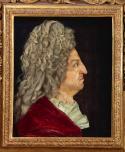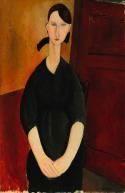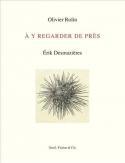Art Of The Day Weekly
#404 - from 29 October 2015 to 4 November 2015
IN THE AIR
Is telepathy a form of art?
METZ – An idea or sensation can be transmitted directly, without the senses intervening. That is what telepathy is, as defined in 1882 in London by Frederic Myers. The mechanism kept psychologists busy and was the matter of research of many a scientist - Marconi carried out his first transmission via radio in 1895 -, immediately fascinated artists, the Surrealists in particular, all fervent believers in a psychic automatic process. The exhibition shows that many other individuals tried to draw an advantage from this, either to photograph the mind –such as Hippolyte Baraduc – or to rewrite the mind waves into music (Biomusic). Even today, artists such as Tony Oursler (whose grandfather was a magician and a friend of Houdini’s), Fabrice Hyber or Sigmar Polke all found deep sources of inspiration in these borders of the unknown.
• Cosa mentale. Les imaginaires de la télépathie dans l’art du XXe siècle at the Centre Pompidou Metz, from 28 October 2015 to 28 March 2016.
EXHIBITIONS

Antoine Benoist (1632-1715), Wax Portrait of Louis XIV at age 68, wax, glass, hair, lace, silk, velvet. 85,3x71x12 cm © Château de Versailles (dist-RMN-GrandPalais), Christophe Fouin
The late King Louis XIV
VERSAILLES – On 1 September 1715, after reigning for 72 years, the Sun-King passed away in his fetish castle. Under the Old Regime, the demise of a sovereign was no light affair– it exalted the deceased but also prepared for the arrival of his successor. While the funeral of Louis XIV did not reach the record of that for François Ier (64 days), they were prepared with pomp and precision: a wax effigy of the sovereign was no longer the tradition but instead the body was embalmed and exhibited, masses were said and medals were struck, the Royal body was divided for three destinations (Saint-Denis, Notre-Dame and the church on rue Saint-Antoine) and the funeral convoy went towards the chapel of Saint-Denis decorated in black, gold and silver. Documents, paintings, mourning attire all bring ‘back to life’ these rituals which authoritarian regimes still cherish.
• Le roi est mort at the Château de Versailles, from 27 October 2015 to 21 February 2016.
Miro, in volumes
BARCELONA – At the end of the 1920s Miró, a lover of collages, covered his works with objects in relief– ropes, nails, hair, feathers, brackets, pebbles and pieces of cork. By then Miro was settled in Paris, where he often met with Magritte and Arp but started to drift away from the Surrealists. As with Picasso, it was inevitable that collage and assemblage drift towards three-dimensional sculpture: this is the theme of the exhibition which details the phases of this process and illustrates drawings, paintings and objects from the Foundation (which celebrates its 40th anniversary) and of international lenders.
• Miró y el objeto at the Fundación Miró, from 29 October 2015 to 17 January 2016
Kanak Eros
LA ROCHELLE – In Kanak art in New Caledonia, engraved bamboo stalks represent an original and ill-known aspect of that culture. They describe scenes of daily life in some cases and are attached in others to real erotic descriptions. The exhibition presents copies done by Roger Boulay of the collection at the museum of Nouméa: copies made with a pen as explorers did before the invention of photography.
• Erotik Kanak at the Museum d’histoire naturelle, from 30 October 2015 to 18 September 2016.
Ungerer in all directions
ZURICH – Toni Ungerer, long known as an illustrator for children’s books, is now 85 years old and went past that status a long time ago. He has been the author of satirical drawings, a poster artist (for The New York Times or the election campaign of Willy Brandt in 1972 for example), director of cartoons, a refined erotomanic artist (his famous Fornicon in 1969, an erotic year) as well as painter and sculptor, designer of urban furniture, among other occupations. This exhibition aims to give a general idea of this polymorphic work, and it can be completed by a visit to the artist’s museum, opened in 2007 in his native city, Strasbourg.
• Tomi Ungerer, Incognito at the Kunsthaus, from 30 October 2015 to 7 February 2016.
AUCTIONS

Amedeo Modigliani, Portrait of Paulette Jourdain. Oil on canvas, 100.3x65.4 cm. Painted circa 1919. Estimate in excess of $25,000,000.
Taubman, in the Sotheby's spirit
NEW YORK – For twenty years he was the boss at Sotheby’s, which he bought in 1983. And he developed it in a remarkable manner. Yet, it was not there that Alfred Taubman made his fortune but rather in shopping centres. His taste for art and his fortune led him to build a unique collection that could only be scattered at Sotheby’s. The contents are the equivalent of a small but very well selected museum of modern art. There are some true icons, such as Portrait of Paulette Jourdain by Modigliani or Woman sitting on a chair , one of the emblematic portraits of Dora Maar by Picasso. But he also had two Rothkos, two Degas (all estimated between 20 and 35 million $) and, in the same bracket (around $15 million), two artists as different as possible, Toulouse-Lautrec (La clownesse Cha-U-Kao) and Clyfford Still, one of the popes of abstract expressionism. Taubman’s last years at the head of Sotheby’s were clouded by the legal action taken in 2001 against his auction house and Christie’s, accusing them of manipulating prices. Taubman was sentenced to a year in jail. A few months after his death, at the age of 91 on 17 April this year, this auction sheds light on another aspect of the man.
• The Collection of A. Alfred Taubman at Sotheby’s, 4 and 5 November 2015.
BOOKS
An eulogy of small things
Engraving used to be a major genre: Durer, Rembrandt, Redon, Picasso all strained their eyes developing that art form. Literature of small objects was also a major genre: Pliny, Virgil, Maeterlinck, Fabre all looked into the lives of ants, pebbles, or worms. This book brings together these two disciplines which time has pushed aside. Erik Desmazières puts into images, with etchings enhanced by ink wash painting, gouache or India ink on ancient ribbed paper, and Olivier Rolin describes, with a cascade of words, taken from technical terminologies or obsolete vocabulary, thus creating a weird treasure chest that is respectful and ironic. Who, what? The asparagus, the fly, cuttlefish bones, pine cones, a germinated potato and the pebble, which had rarely been invited to such a delightful party. The work, both spiritual and scholarly, descriptive and poetic, is a real delight which rightfully so is under the aegis of Ponge, a pioneer in the rediscovery of these objects long forgotten by Nature and daily life.
• A y regarder de près, by Olivier Rolin and Erik Desmazières, Seuil, 2015, 128 p., €25.
OPENINGS OF THE WEEK

CLARK & POUGNAUD
29 October 2015 - LILLE - Maison de la Photographie
A photographer and a painter pay tribute to Edward Hopper and other poets of loneliness
IN BRIEF
BAMAKO – The 10th edition of Rencontres de Bamako, the African photography biannual event, will be held from 31 October to 31 December 2015.
PARIS - The 2015 Marcel Duchamp prize has been awarded to Melik Ohanian.
PARIS - The Ricard Corporation prize has been awarded to Florian Pugnaire and David Raffini.
TORINO - The modern and contemporary art fair Artissima will be held from 6 to 8 November 2015.

